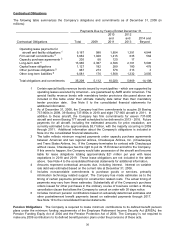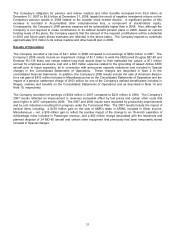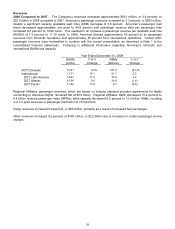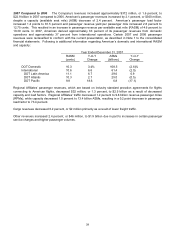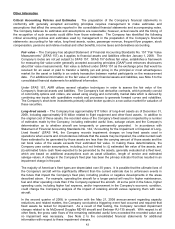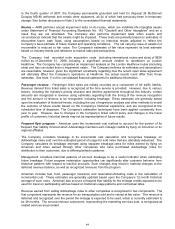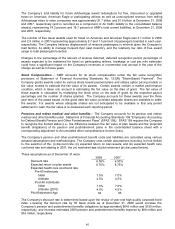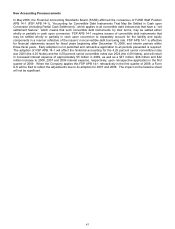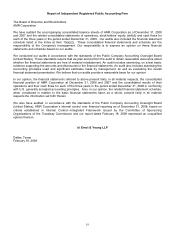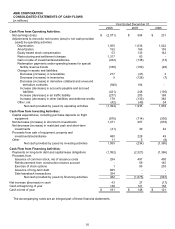American Airlines 2008 Annual Report Download - page 49
Download and view the complete annual report
Please find page 49 of the 2008 American Airlines annual report below. You can navigate through the pages in the report by either clicking on the pages listed below, or by using the keyword search tool below to find specific information within the annual report.46
The expected return on plan assets is based upon an evaluation of the Company's historical trends and
experience taking into account current and expected market conditions and the Company’s target asset
allocation of 35 percent longer duration corporate and U.S. government/agency bonds, 25 percent U.S.
value stocks, 20 percent developed international stocks, five percent emerging markets stocks and bonds
and 15 percent alternative (private) investments. The expected return on plan assets component of the
Company’s net periodic benefit cost is calculated based on the fair value of plan assets and the Company’s
target asset allocation. The Company monitors its actual asset allocation and believes that its long-term
asset allocation will continue to approximate its target allocation. The Company’s historical annualized ten-
year rate of return on plan assets, calculated using a geometric compounding of monthly returns, is
approximately 6.81 percent as of December 31, 2008. This rate of return was significantly impacted by
market conditions in the latter half of 2008. Lowering the expected long-term rate of return on plan assets
by 50 basis points as of December 31, 2008 would increase estimated 2009 pension expense by
approximately $32 million.
The health care cost trend rate is based upon an evaluation of the Company's historical trends and
experience taking into account current and expected market conditions. Increasing the assumed health
care cost trend rate by 100 basis points would increase estimated 2009 postretirement benefits expense by
$20 million.
In 2007, the Fair Treatment for Experienced Pilots Act (H.R. 4343) was signed into law, raising the
mandatory retirement age for commercial pilots from 60 to 65. Previously, The Federal Aviation
Administration required commercial pilots to retire once they reached age 60. The Company’s pilot pension
and other postretirement plans continue to permit a pilot to retire as before at age 60, but the Company
believes that many pilots will choose to fly past age 60. As a result of the new legislation, the Company has
estimated the average retirement age for the pilot workgroup to be 63, based on the approximate retirement
age of the Company’s other work groups, which did not have the same mandatory retirement age. This
change in the estimate caused a decrease to the pension and other postretirement liability of approximately
$543 million in 2007. See Note 10 to the consolidated financial statements for additional information.
Income taxes – The Company generally believes that the positions taken on previously filed income tax
returns are more likely than not to be sustained by the taxing authorities. The Company has recorded
income tax and related interest liabilities where the Company believes its position may not be sustained or
where the full income tax benefit will not be recognized. In accordance with the standards of Financial
Accounting Standards Board Interpretation No. 48 “Accounting for Uncertainty in Income Taxes- an
interpretation of FASB Statement No. 109” (FIN 48), the effects of potential income tax benefits resulting
from the Company’s unrecognized tax positions are not reflected in the tax balances of the financial
statements. Recognized and unrecognized tax positions are reviewed and adjusted as events occur that
affect the Company’s judgment about the recognizability of income tax benefits, such as lapsing of
applicable statutes of limitations, conclusion of tax audits, release of administrative guidance, or rendering of
a court decision affecting a particular tax position. Under SFAS 109, the Company records a deferred tax
asset valuation allowance when it is more likely than not that some portion or all of its deferred tax assets
will not be realized. The Company considers its historical earnings, trends, and outlook for future years in
making this determination. The Company had a deferred tax valuation allowance of $2.7 billion and $625
million, respectively, at December 31, 2008 and 2007. See Note 8 to the consolidated financial statements
for additional information.
Derivatives – As required by Statement of Financial Accounting Standards No. 133, “Accounting for
Derivative Instruments and Hedging Activity” (SFAS 133), the Company assesses, both at the inception of
each hedge and on an on-going basis, whether the derivatives that are used in its hedging transactions are
highly effective in offsetting changes in cash flows of the hedged items. In doing so, the Company uses a
regression model to determine the correlation of the change in prices of the commodities used to hedge jet
fuel (e.g. NYMEX Heating oil) to the change in the price of jet fuel. The Company also monitors the actual
dollar offset of the hedges’ market values as compared to hypothetical jet fuel hedges. The fuel hedge
contracts are generally deemed to be “highly effective” if the R-squared is greater than 80 percent and the
dollar offset correlation is within 80 percent to 125 percent. The Company discontinues hedge accounting
prospectively if it determines that a derivative is no longer expected to be highly effective as a hedge or if it
decides to discontinue the hedging relationship. As of December 31 2008, the Company had derivative
contracts in a net liability position at fair value of $528 million including a liability related to contracts that
settled in December. A deferred loss of $876 million was recorded in Other comprehensive income at
December 31, 2008, and will be recognized in future periods as contracts settle.


